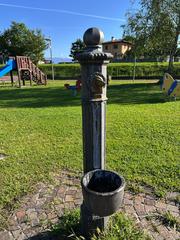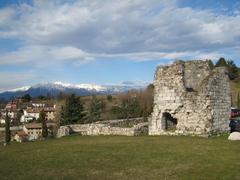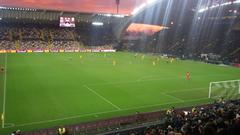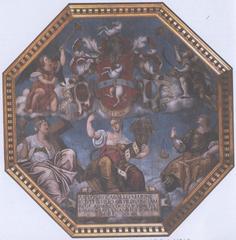Visiting Castello Di Brazzà: Hours, Tickets, and Tips
Date: 17/08/2024
Introduction
Nestled in the picturesque province of Udine, Italy, Castello di Brazzà stands as an enduring testament to centuries of history and architectural evolution. This iconic landmark, with its roots tracing back to the medieval period, offers a unique experience for history buffs, architecture enthusiasts, and casual travelers alike. Originally built in the 13th century as a defensive stronghold by the Brazzà family, the castle has undergone numerous transformations over the centuries. From its robust medieval structure to its elegant Renaissance modifications, Castello di Brazzà encapsulates a rich tapestry of historical and architectural heritage (source). The Brazzà family, including notable figures like Pietro Savorgnan di Brazzà, has played a significant role in shaping the region’s history, leaving behind a legacy that is commemorated both locally and globally, such as in the capital city of the Republic of the Congo, Brazzaville (source). Whether it’s exploring the well-preserved architecture, delving into the historical exhibits at the Spazio Brazzà museum, or enjoying the beautifully landscaped gardens, a visit to Castello di Brazzà offers a comprehensive and enriching experience (source).
Table of Contents
- Introduction
- Early Origins and Construction
- Architectural Evolution
- The Brazzà Family
- Historical Significance
- The 1511 Idrija Earthquake
- Modern Era and Preservation
- Visitor Information
- Nearby Attractions
- Local Cuisine
- FAQ
- Conclusion
Early Origins and Construction
Castello di Brazzà, located in the province of Udine, Italy, is a historical edifice with roots tracing back to the medieval period. The castle’s origins are intertwined with the history of the Brazzà family, a noble lineage that played a significant role in the region’s development. The initial construction of the castle dates back to the 13th century, a period marked by feudal conflicts and territorial expansions. The castle was strategically built to serve as a defensive stronghold, protecting the surrounding lands from invasions and providing a secure residence for the Brazzà family.
Architectural Evolution
Over the centuries, Castello di Brazzà underwent several architectural transformations, reflecting the changing tastes and needs of its inhabitants. The original medieval structure, characterized by its robust defensive features such as thick walls, battlements, and a central keep, gradually evolved into a more refined and comfortable residence. During the Renaissance period, significant modifications were made to the castle, incorporating elements of Renaissance architecture. These changes included the addition of elegant facades, spacious courtyards, and ornate interiors, transforming the castle into a symbol of prestige and power.
The Brazzà Family
The Brazzà family, also known as the Savorgnan di Brazzà, has a storied history that is closely linked to the castle. The family rose to prominence in the region through their military prowess and strategic alliances. One of the most notable members of the family was Pietro Savorgnan di Brazzà, an explorer and colonial administrator who played a crucial role in the French colonization of Central Africa. His legacy is commemorated in the name of the capital city of the Republic of the Congo, Brazzaville.
Historical Significance
Castello di Brazzà holds significant historical importance due to its association with key events and figures in the region’s history. During the medieval period, the castle served as a focal point for the defense against invasions and as a center of administration for the surrounding territories. The castle’s strategic location allowed it to control important trade routes and maintain influence over the region. In the Renaissance period, the castle became a hub of cultural and intellectual activity, hosting notable artists, scholars, and dignitaries.
The 1511 Idrija Earthquake
One of the pivotal events in the history of Castello di Brazzà was the 1511 Idrija earthquake, which caused widespread destruction in the region. The earthquake severely damaged the castle, necessitating extensive reconstruction efforts. The rebuilding process provided an opportunity to incorporate contemporary architectural styles and innovations, resulting in the Renaissance-inspired modifications that are evident today. The earthquake and subsequent reconstruction efforts are a testament to the resilience and determination of the Brazzà family and the local community.
Modern Era and Preservation
In the modern era, Castello di Brazzà has been preserved as a historical monument, attracting visitors from around the world. The castle’s well-preserved architecture and rich history make it a popular destination for tourists and history enthusiasts. Efforts have been made to maintain the castle’s structural integrity and historical authenticity, ensuring that future generations can appreciate its historical and cultural significance. Today, the castle serves as a venue for cultural events, exhibitions, and educational programs, providing visitors with a deeper understanding of the region’s history and heritage.
Visitor Information
Opening Hours and Tickets
Castello di Brazzà is typically open to visitors from 9:00 AM to 6:00 PM. It is advisable to check the official website for any changes in opening hours or special events. Ticket prices vary, with discounts available for students, seniors, and groups. It’s recommended to purchase tickets in advance during peak tourist seasons.
Guided Tours
Guided tours are available and highly recommended for a comprehensive understanding of the castle’s history and architecture. Tours are often conducted in multiple languages, including English and Italian.
Accessibility
The castle is accessible to visitors with mobility impairments, with ramps and elevators available in key areas. However, some parts of the castle may have limited accessibility due to the historical nature of the building.
Photography
Photography is allowed in most areas of the castle, but the use of flash and tripods may be restricted. It is advisable to check with the staff before taking photographs. The castle offers numerous picturesque spots perfect for capturing memories.
Nearby Attractions
The castle is located in the picturesque region of Udine, which offers a variety of attractions, including historical sites, museums, and scenic landscapes. Visitors can explore the nearby Udine Castle, which hosts the History and Art Museum of the City of Udine (source).
Local Cuisine
The region is known for its delicious cuisine, and visitors are encouraged to try local specialties such as frico (a cheese and potato dish) and prosciutto di San Daniele. There are several restaurants and cafes in the vicinity of the castle where visitors can enjoy authentic Italian meals.
FAQ
What are the visiting hours for Castello di Brazzà?
The castle is typically open from 9:00 AM to 6:00 PM. Check the official website for any changes.
How much are tickets to Castello di Brazzà?
Ticket prices vary, with discounts available for students, seniors, and groups.
Is Castello di Brazzà accessible to visitors with mobility impairments?
Yes, the castle is accessible with ramps and elevators in key areas, though some parts may have limited accessibility.
Can I take photographs inside Castello di Brazzà?
Yes, photography is allowed in most areas, but the use of flash and tripods may be restricted.
Conclusion
Castello di Brazzà stands as a testament to the rich history and cultural heritage of the Udine region. Its architectural evolution, historical significance, and association with the Brazzà family make it a fascinating destination for visitors. By preserving and promoting the castle, the local community ensures that this historical gem continues to inspire and educate future generations. For more updates and to plan your visit, be sure to check out our mobile app Audiala, and follow us on social media.
References
- Wikipedia contributors. (n.d.). Udine castle. In Wikipedia, The Free Encyclopedia. Retrieved from Wikipedia
- Castello di Brazzà. (n.d.). Fey Von Hassell. Retrieved from Castello di Brazzà
- Welcoming Estates Website. (n.d.). Castello di Brazzà. Retrieved from Welcoming Estates Website
- Italy on This Day. (2022). Pierre Savorgnan de Brazza explorer. Retrieved from Italy on This Day
- Castello di Brazzà. (n.d.). Il Museo. Retrieved from Castello di Brazzà



